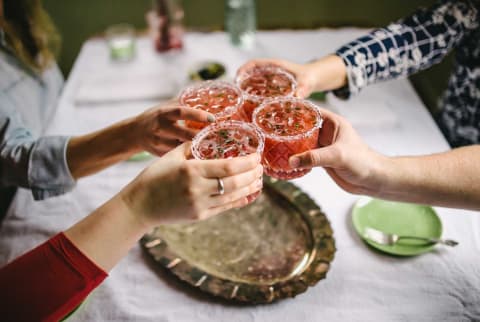
Our editors have independently chosen the products listed on this page. If you purchase something mentioned in this article, we may earn a small commission.
September 30, 2021 — 20:40 PM
As the seasons shift, so do the available items on produce shelves and, of course, in farmers markets. While we’re familiar with the flavors and even the immune-supporting benefits of some of our favorite fall produce, it turns out our autumnal haul may offer even more perks. We’re all for multi-use items around here, so why not look for foods you can reap multiple benefits from?
Certified Nutritionist and celebrity chef Serena Poon, C.N., CHC, CHN shares some potential beauty gains of those fall fruits and veggies—whether you’re cooking with them or using in DIY beauty products
Functional Nutrition Coaching
Advice from the world’s top doctors and experts, at your fingertips.

Probably the most iconic fall harvest, pumpkins can be used in sweet and savory applications (and, yes, even in coffee). But have you ever thought of how it helps your skin? “Our skin tends to dry out and build up excess dead skin cells during colder months, leaving our skin looking dull,” Poon tells mindbodygreen. One easy solution to dull skin? A gentle face exfoliator: “Pumpkins are packed with natural fruit enzymes and AHAs to exfoliate the skin.” In fact, pumpkins show up in some of our favorite beauty products, like this Naturopathica Clarifying Pumpkin Enzyme Peel or Savor Beauty’s Pumpkin Enzyme Peel.
So while you’re making your pumpkin-packed fall dishes (get all of our favorite pumpkin recipes here), set some aside for your own DIY mask. Just blend together your pumpkin puree with a healthy drizzle of manuka honey or olive oil. Apply it to your face for 10-15 minutes, rinse, and then apply your go-to face moisturizer.
Looking for a way to work fall produce into your skincare routine? Look for cranberry! “Cranberry seed oil is especially rich with skin-protecting ingredients,” Poon says. “It contains forms of Vitamin E and other antioxidants that protect the skin from environmental stressors, along with omega-3, omega-6, and omega-9 essential fatty acids that moisturize. Plus, it smells delicious and absorbs quickly into the skin.” You can either purchase pure cranberry seed oil—or find it pre-formulated into products, like this Cowshed Rejuvenating Facial Oil.
If you’re planning to use the fruit in cooking, there are plenty of inside-out benefits, too: “The fruit itself is rich in nutrients, including Vitamin C, as well as potassium and manganese,” she says. If you’re looking to cook with it, try this fermented cranberry salsa recipe.
“Beets get their bright red color from betalain, an incredible antioxidant with anti-inflammatory benefits,” says Poon. For beauty benefits, she says you can try using the juice in as a DIY scalp rinse, especially if you have a drier scalp.
However, a major note of caution (that you’re likely familiar with if you’ve ever cooked with beets): The juice can stain your hair. So much so that the ingredient is even commonly used in natural-toning products like purple shampoos. If you have dark hair, you have less to worry about here, but for those with light hues you run the risk of temporarily dying your hair a nice violet shade. (Hey, maybe you’re going for that! Then by all means.) Do a small strand test prior to make sure your hair doesn’t pick up any of the pigment. If it does, simply rinse with a clarifying shampoo and warm water: The results are only temporary—we promise!
If you want to bring your beets into the kitchen for their various nutrition benefits (more on that here), this Egyptian-inspired dish is a great use of roasted beets and you can even add them to a pink goddess salad dressing.
Another example of vibrant color indicating benefits: “Pomegranate is rich in Vitamin C, a proven skin-protecting antioxidant with free-radical fighting and anti-inflammatory benefits,” she says. “Pomegranate peel extracts are rich in tannins, that help lock in color pigments to hair fibers, which help keep hair colors more vibrant.” You can read all about the topical benefits of pomegranate oil and extract here—with a few DIY recipes, too.
If you’re looking to add pomegranates to your diet (other than as a snack), they’re a perfect trifecta with two other Mediterranean ingredients: pistachios and citrus.
Another great reason to snack on carrot sticks this fall? They’re great for our skin. “Carrots are rich in beta-carotene, a powerful antioxidant that protects the skin from free radical exposure.” For topical usage, you’re going to want to look for carrot seed oil—check out a DIY face oil recipe that includes it here.
Though it may seem simple, roasted carrots can be seriously dressed up—or repurposed, like in this low-FODMAP “hummus.” While they don’t have the same benefits, carrot greens are edible, too.
Unsurprisingly, their similar color means sweet potatoes share some benefits with carrots—specifically, those from beta-carotene. In addition, Poon says the root vegetable is “also rich in pantothenic acid, a moisturizing molecule that hydrates and nourishes the skin.” They’re also a good source of tons of vitamins, like vitamin A, B, and C. But sweet potatoes aren’t the easiest option to DIY with—so for now we recommend these delicious foods just for eating.
There’s so many ways to use sweet potatoes in the kitchen, but we’re partial to these baked, dressed up fries and using them as the base for a complete meal.
So when you hit the farmers market this fall, keep in mind that some of your favorite produce might just be providing some beauty benefits—from the inside out.
https://www.mindbodygreen.com/articles/rd-approved-skin-supporting-fall-foods








